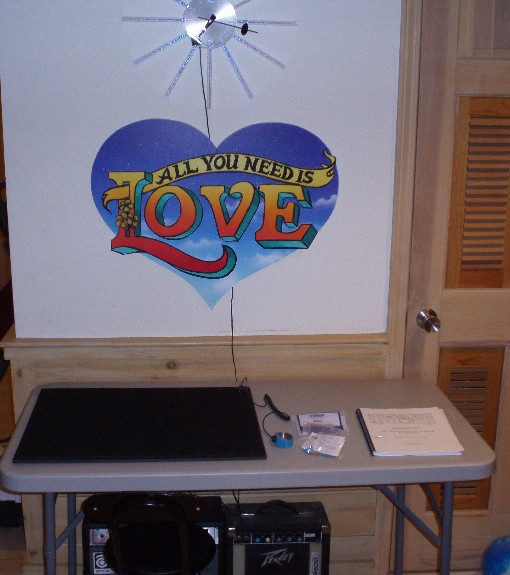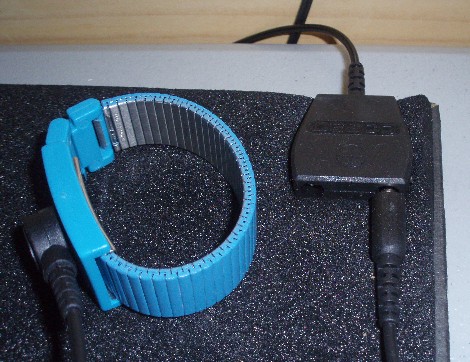My Elecraft K3 Experience
Eliot Mayer,
W1MJ
Updated 12/29/2012 (Added
"Phone Contesting on the Cheap")
A Unique Beginning
| I've been an amateur radio
operator for 40 years (yikes!), and never had a really
good radio. My present home station consists of an Icom
IC-706MKIIG, a pretty good rig, but not high end. When
the Elecraft K3
came out, and got such good reviews, I decided I would
get one after the last of the children graduated college
in 2011. I liked the idea of the no-solder kit, where I
could take some pride in assembling it myself, but not
have to deal with surface-mount soldering. But with one
more daughter still in college, some strange and
wonderful things happened over the summer of 2010. First, Jon Pellant, W1JP, brought his K3 up
from NYC for the WARA / CC-ARC Field Day. When Jon headed home, he inadvertently
left the manual behind at the site. When I emailed him,
he said not to bother sending it back, as he had the PDF
file. So I kept it and read it voraciously like a
can't-put-it-down novel.
Later in the summer, a UPS notice
showed up on my door for a delivery from Elecraft. How
strange! I called Elecraft to see if they had made a
mistake. The woman who answered the phone asked me,
"Did you open it?" I said no. She said, in a
mysterious manner, "I suggest that you open
it". I asked if she knew what it was. She said yes.
I said, "You're not going to tell me, are you?"
She said no.
When I got home, my wife Irina had
picked up the box from UPS on her way home from work. I
was mystified, but Irina, being much brighter than me,
said that it must be from my best friend Bones (Rick
Palm, K1CE). She guessed correctly that it was his way of
saying thanks for all the support I had given him before
and since the recent passing of his beloved wife, Joanne
Palm, W1GUN. Bones and Joanne met while both employed at
ARRL Headquarters in Newington, CT, and they later moved
for Florida.
Then, within 2 days of the K3's
arrival, I received snail mail from W1JP, saying that he
wanted his K3 manual back after all, and to please send
it back in the enclosed s.a.s.e. I felt like Jim Carey in
"The Truman Show".
|
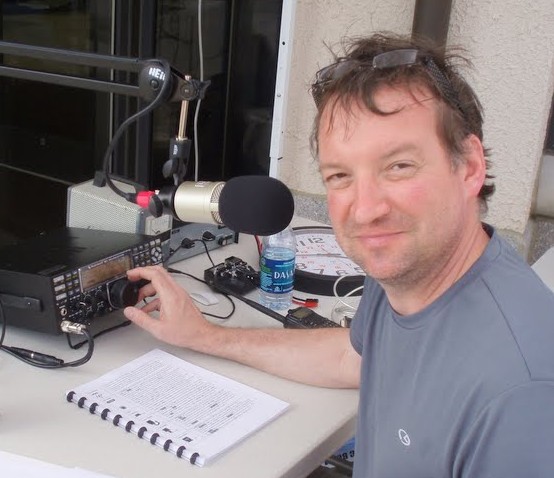
W1JP and his K3 at FD 2010
K1CE & W1MJ climbing Mt.
Washington, NH, September 2010
|
Accessorizing
The New England ARRL Convention came shortly after the K3's arrival, and gave me
the opportunity to get advice on options and accessories from
Elecraft co-founder Eric Swartz, WA6HHQ. He asked how I planned
to use the rig. When I told him that I was mostly interested in
CW, and also wanted to use the rig on SSB on Field Day, he
advised me to get the 400 Hz and 2.8 kHz 8-pole roofing filters.
I also ordered the MH2 hand mike. Elecraft paid the shipping
charge on orders placed at the convention.
Work Area
I took seriously Elecraft's suggestion of
setting up an "ESD Safe" work space that would not
cause static damage to the components during assembly.
I set up a kit building work area
consisting of:
- 4' x 2' folding table, from Wal-mart
"Site to Store"
- Protektive Pak 37676 ESD Mat, from Stanley Supply
- Desco 09821 Common Ground Cord, 10mm
Socket, w/resistor, from Stanley Supply
- 3M AMWS61M Metal Wrist Band & 6'
Coil Cord, from Stanley Supply
Initially, based on an error on the Stanley
web site, I bought a Desco cord that would not mate with the mat
because both parts had the same gender. Stanley was nice about
correcting the error, and I see that they've corrected their web
page to show the correct matching cord. Even the correct cord was difficult to plug onto
the mat, as I had to squish down the foam around the connector,
but it worked out OK.
Inventory
As in my old Heathkit building days, I also
took seriously the instruction to do a parts inventory prior to
building the kit. Besides making sure everything is present, this
also gave me familiarity with the parts. And as I counted the
hardware, I sorted the screws and such into clear sandwich bags
with labels that made the parts easy to find during assembly.
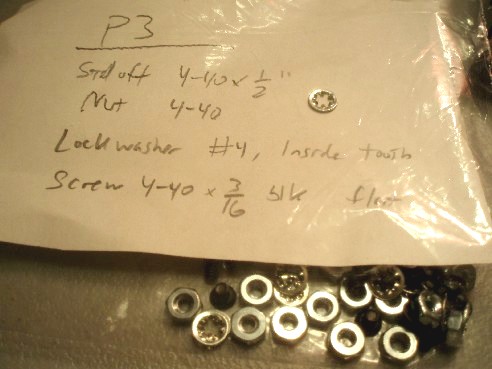
There were some apparent discrepancies
between the inventory appendix in the K3 manual and the actual
parts I received, but Elecraft resolved the issues fairly quickly
through an exchange of emails. In the end, nothing was missing,
and Elecraft has addressed at least some of the discrepancies in
their latest "Assembly Manual Errata".
Assembly
Finally, with a proper work area and a
complete inventory, I started building the kit. I found the
instructions to be very clear, with plenty of accompanying photos
- as good as the instructions provided by Heathkit when I built
my HW-101 as a teenager. I did have a few questions during
assembly, but as with my inventory questions, I received swift
responses from Elecraft - even on Sunday evenings!


The hard part is finding the time to
assembly the kit. I'm trying to get into the habit of getting
through a couple of checkmarks in the assembly manual per day,
but even that isn't always feasible. But I'll get there
eventually.

Front-panel assembly completed. I think I'm
about half way there.
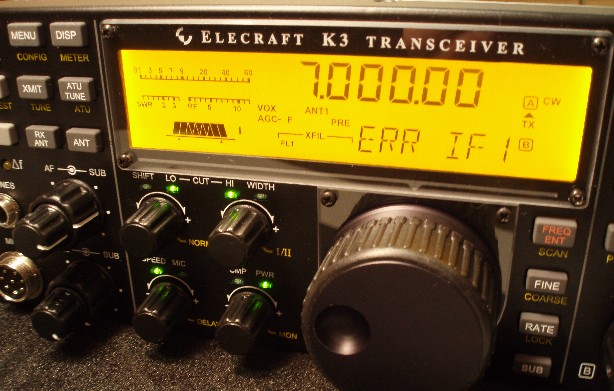
The initial smoke test. The smoke did not
escape - yeah!
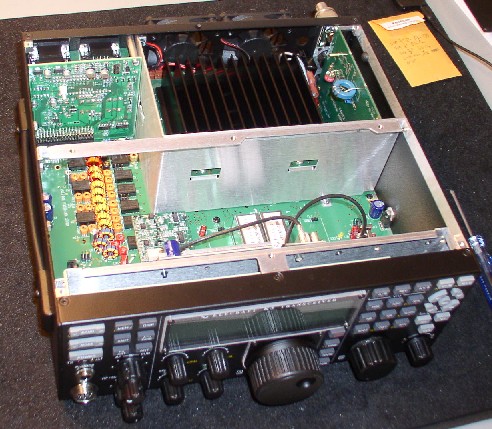
The final step was installing the 100-watt
final amplifier option (rear right with heat sink)

And finally, the day after Thanksgiving,
the rig is complete and on the air. My first contact was with
Bones, K1CE. Then I gave it a workout on CW during the CQ WW DX
Contest and ARRL 160M contest. In this photo, I was using the CW
text decoder to show my grandson Dima his name as I was sending
it using my Begali paddle and the K3's internal keyer.
Interfacing
Interfacing the K3 with my computer for
firmware updates, rig control, and CW was very easy. It only
requires an off-the-shelf "9M-9F" serial cable. I used
a shielded cable, Radio Shack 26-1402. On a second such cable
bought in 2012, I had to unscrew two pieces of hardware that
prevented the cable from plugging into the K3:
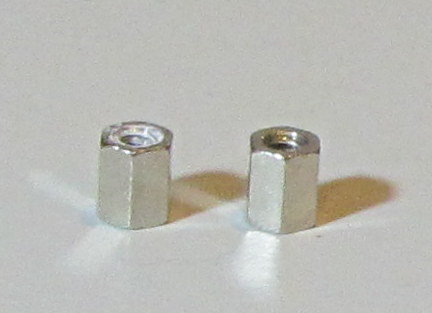
The setup in N1MM Logger was easy - I used the same serial port lines for CW
and PTT as I did for my IC706MKIIG, and set the K3 CONFIG:PTT-KEY
to match. If I disable the PTT control in N1MM, I can send CW in
QSK (full break-in) mode, but I haven't done so. I used to like
QSK on my old Ten Tec Argosy, but I guess the older me doesn't
want the distraction.
The K3 has built-in RTTY and PSK31
functionality, but I haven't found away to use it with N1MM
Logger. The K3 doesn't require a Rig Blaster or similar
interface, as it has audio line in and line out connectors. I
just use ordinary cables from the rig to the computer, Radio
Shack 42-2387 and 42-0758. These cables are different colors to
help prevent mix-ups, though I also label the cable ends.
Continual Learning
Once I had assembled and hooked up the K3,
I realized that I still had to learn how to operate it. Basic
operation is not difficult, and the manual is good. But taking
advantage of all the features is a continual learning process.
For example, I originally didn't find the
noise blanker useful. I had been focusing on the digital noise
blanker, which doesn't seem to help with my local noise sources.
Then with guidance from George W1LSB, I learned that the analog
noise blanker works really well for some of my local
noise sources, tought not all. The best noise reduction feature
for CW is the WIDTH control - you can go as narrow as 50 or 100
Hz with no ringing.
First DXpedition
In March, 2011, I operated on St. John in
the U.S. Virgin Islands. I installed the optional antenna tuner
before going, and bought a balun so that I could connect a
twin-lead fed dipole. This was a "hamcation" -
primarily a vacation with my wife Irina, with some hamming on the
side.
Unfortunately, I forgot the connector that
mates the balun with the radio. I kluged something together, but
it must have been intermittent, and I had smoke coming out of the
radio - Yikes !!! Fortunately, Electraft's incredible support
people came through for me via email. From my detailed
description, they figured out that an inductor on the new tuner
had burned up. They explained that it was part of a trap to
prevent the rig from radiating some internal 8 MHz signal, and
since I was on some island where I probably wouldn't bother
anyone, they suggested bypassing the trap. They sent detailed
instructions, and it worked! When I got home, a replacement
inductor was waiting for me. Some day, I might even install it. A
St. John ham, KP2G, kindly lent me a cable for connecting the
balun properly to the radio.
St. John DXpedition Photos
Phone Contesting on the Cheap
At the WARA / CC-ARC 2012 Field Day, I learned from Phil KB1FIY that an ordinary
computer headset, typically used for Skype and similar PC
programs, can be used on the K3 via rear-panel connectors. On the
main menu, with the rig in SSB mode, MIC SEL should be set to
RP.L BIAS. The next menu item, MIC+LIN, can be set to ON if you
want to send canned messages from the computer logging program. I
have done this with N1MM
Logger. Just bear in mind that the
microphone is active during canned messages, so be quiet.
Contesters typically use a footswitch along
with the headset. Phil told me that he got one intended for
musical keyboards. I found such a footswitch for $15 at Guitar
Center, the Live Wire LWS25
Keyboard Sustain Pedal. It has a polarity switch which should be
set to Normally Open. From the same rack, I picked up a
1/4"phone-to-RCA(phono) connector adapter. Another option is
to just change the connector to RCA (phone), as Phil did with his
footswitch.
During the WRTC 2012 test operation, a
serious phone contester at my site spend several hours with this
setup and made a lot of contacts. He said that he liked the $20
Radio Shack computer headset better than his expensive Heil because it was lighter and more comfortable for
long contesting sessions. It might be blasphemous, but I'm
thinking that the high ratings for Heil headsets are mostly hype.
Eliot's Home
Page


